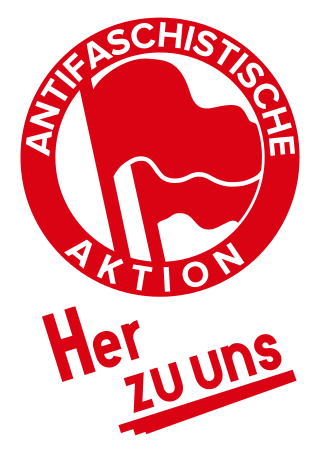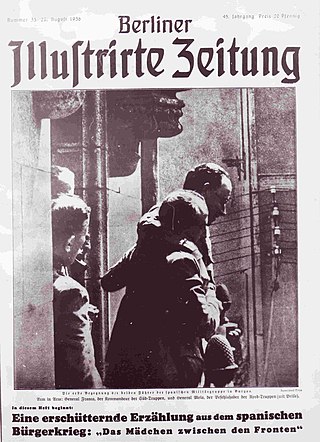Related Research Articles

Austrian Nazism or Austrian National Socialism was a pan-German movement that was formed at the beginning of the 20th century. The movement took a concrete form on 15 November 1903 when the German Worker's Party (DAP) was established in Austria with its secretariat stationed in the town of Aussig. It was suppressed under the rule of Engelbert Dollfuss (1932–34), with its political organization, the DNSAP banned in early 1933, but was revived and made part of the German Nazi Party after the German annexation of Austria in 1938.

The Ullstein Verlag was founded by Leopold Ullstein in 1877 at Berlin and is one of the largest publishing companies of Germany. It published newspapers like B.Z. and Berliner Morgenpost and books through its subsidiaries Ullstein Buchverlage and Propyläen.

The Nazi Party/Foreign Organization was a branch of the Nazi Party and the 43rd and only non-territorial Gau ("region") of the Party. In German, the organization is referred to as NSDAP/AO, "AO" being the abbreviation of the German compound word Auslands-Organisation. Although Auslands-Organisation would be correctly written as one word, the Nazis chose an obsolete spelling with a hyphen.

Antifaschistische Aktion was a militant anti-fascist organisation in the Weimar Republic started by members of the Communist Party of Germany (KPD) that existed from 1932 to 1933. It was primarily active as a KPD campaign during the July 1932 German federal election and the November 1932 German federal election and was described by the KPD as a "red united front under the leadership of the only anti-fascist party, the KPD."
Franz Eher Nachfolger GmbH was the central publishing house of the Nazi Party and one of the largest book and periodical firms during the Nazi regime. It was acquired by the party on 17 December 1920 for 115,000 Papiermark.
Friedrich Blume was professor of musicology at the University of Kiel from 1938 to 1958. He was a student in Munich, Berlin and Leipzig, and taught in the last two of these for some years before being called to the chair in Kiel. His early studies were on Lutheran church music, including several books on J.S. Bach, but broadened his interests considerably later. Among his prominent works were chief editor of the collected Praetorius edition, and he also edited the important Eulenburg scores of the major Mozart Piano Concertos. From 1949 he was involved in the planning and writing of Die Musik in Geschichte und Gegenwart.
Beefsteak Nazi or "Roast-beef Nazi" was a term used in Nazi Germany to describe communists and socialists who joined the Nazi Party. Munich-born American historian Konrad Heiden was one of the first to document this phenomenon in his 1936 book Hitler: A Biography, remarking that in the Sturmabteilung ranks there were "large numbers of Communists and Social Democrats" and that "many of the storm troops were called 'beefsteaks' – brown outside and red within". The switching of political parties was at times so common that SA men would jest that "[i]n our storm troop there are three Nazis, but we shall soon have spewed them out".
German individualist philosopher Max Stirner became an important early influence in anarchism. Afterwards Johann Most became an important anarchist propagandist in both Germany and in the United States. In the late 19th century and early 20th century there appeared individualist anarchists influenced by Stirner such as John Henry Mackay, Adolf Brand and Anselm Ruest and Mynona.

The Berliner Illustrirte Zeitung, often abbreviated BIZ, was a German weekly illustrated magazine published in Berlin from 1892 to 1945. It was the first mass-market German magazine and pioneered the format of the illustrated news magazine.
Erich Maschke was a German historian, history professor, and Nazi ideologue. He last taught at Heidelberg University. During the Nazi era he promoted racist and nationalist ideology. After the war he led the so-called Maschke Committee, commissioned by the West German parliament, which investigated the treatment of German prisoners-of-war during and after World War II by the Allies.
Uhu was a monthly magazine published from 1924 to 1934 in Berlin by Ullstein Verlag. Today it is considered a pioneering publication of the Weimar period.

August Winnig was a German politician, essayist and trade unionist.

Otto Friedrich Wilhelm Stapel, was a German Protestant and nationalist essayist. He was the editor of the influential antisemitic monthly magazine Deutsches Volkstum from 1919 until its shutdown by the Nazis in 1938.
Ilse Erika Korotin is an Austrian philosopher and sociologist. She researched and published on the history of ideas of Nazism. At the Institute for Science and Art in Vienna, she heads the Documentation Centre for Women's Studies. Her work focuses on feminist biographical research and history of science.
This is a list of selected papers or books about the Holocaust in Greece.

Die Brennessel was a weekly satirical magazine which was published in Munich, Germany, between 1931 and 1938. It was one of the publications which were established to gain popularity among Germans in favor of the Nazi Party. The magazine employed humor as a tool for Nazi propaganda.
Theodor Neubauer was a German communist politician, educator, essayist, historian and anti-Nazi resistance fighter.

Tempo was a daily newspaper published in Germany between 1928 and 1933, with Berlin as its main area of distribution.
Angela Zigahl was a German teacher and politician who served in the Landtag of Prussia from 1925 until 1933. A member of the Centre Party, she represented the Oppeln constituency. Following World War II, Zigahl was a member of the Sonne Commission, an American-led body which sought to resolve the post-war refugee crisis in West Germany.

Franz Ullstein (1868-1945) was a German Jewish publisher and art collector persecuted by the Nazis
References
- ↑ Hanno Hardt (1989). "Pictures for the Masses: Photography and the Rise of Popular Magazines in Weimar Germany". Journal of Communication Inquiry . 13 (1): 13–14. doi:10.1177/019685998901300101. S2CID 140771173.
- 1 2 Volker Bendig (2014). Die populärwissenschaftliche Zeitschrift Koralle im Ullstein und Deutschen Verlag 1925-1944 (PhD thesis) (in German). Ludwig Maximilian University of Munich. doi:10.5282/EDOC.20212.
- 1 2 3 "Presse in der Zeit des Nationalsozialismus. Presse im Nationalsozialismus". Deutsche Digitale Bibliothek (in German). 8 September 2021. Retrieved 1 September 2023.
- 1 2 Arne Schirrmacher (July 2013). "Popular Science as Cultural Dispositif: On the German Way of Science Communication in the Twentieth Century". Science in Context. 26 (3): 483–484, 488. doi:10.1017/s026988971300015x. S2CID 144232280.
- ↑ Daniel Horn (June 2013). The boon of barbarism. Returns on an idea in contemporary art and politics (MA thesis). Heidelberg University. p. 32. doi:10.11588/ARTDOK.00007165.